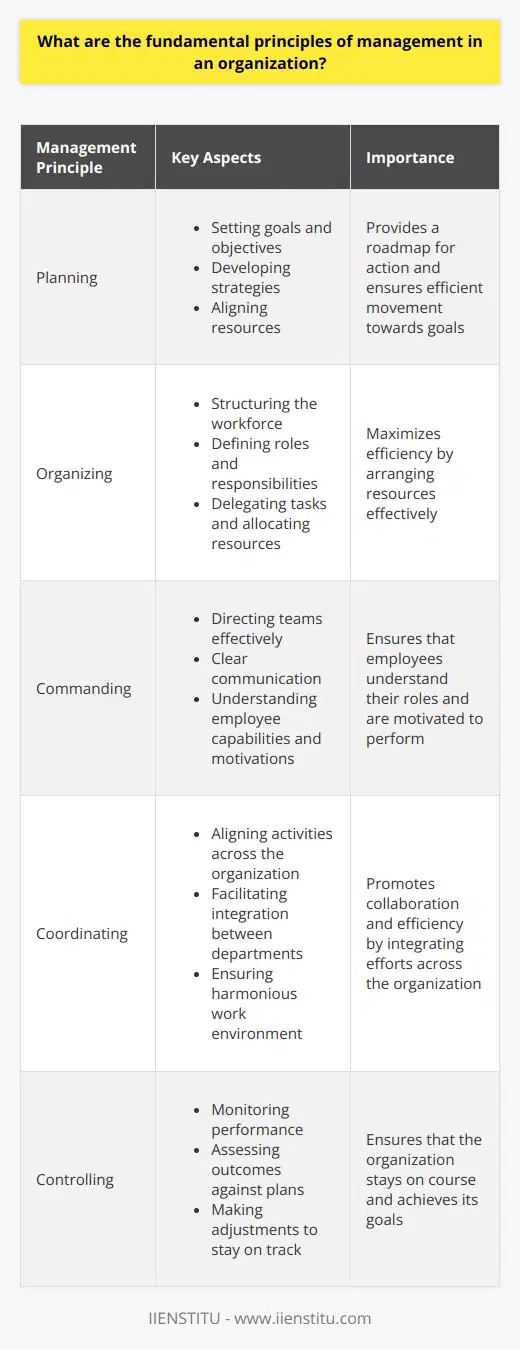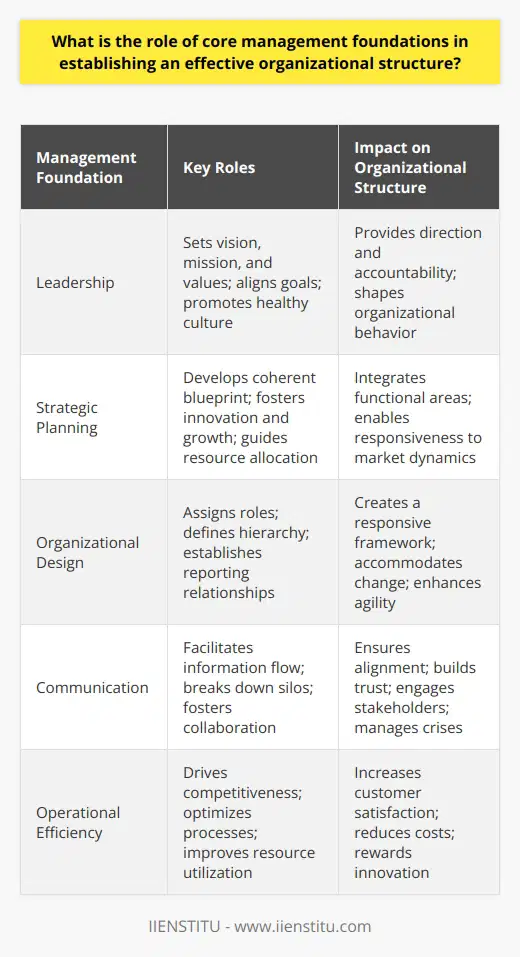
In the quest for excellence and sustainable success, Core Management Foundationsremain central to any successful organization. These foundations provide the bedrock upon which all aspects of Organizational Management are built, incorporating a wide array of practices and principles essential to the strategic execution of business goals and initiatives. Effective management extends beyond mere control and coordination, demanding an intimate understanding of Business Administration Principles, organizational dynamics, and human behavior.
The importance of establishing robust and adaptable Organizational Structures cannot be overstated. In an era characterized by rampant technological progression and perpetual change, structured yet flexible management approaches are vital. Furthermore, the development and implementation of cogent Leadership Strategies ensure that organizations are laced with visionary direction and purpose-driven motivation.
This blog piece aims to dissect each of these critical components, delineating their individual importance and interconnectivity while offering actionable insights to business professionals and enthusiasts alike. Whether pursuing an online MBA or investing in online courses to sharpen administrative acumen, understanding these foundational principles is indispensable in the current business paradigm.
Establishing Organizational Management Framework

Foundations of Organizational Structure
At the heart of every organization lies its structure - a critical determinant of its operational efficacy. The choice between Hierarchical versus Flat Organizations marks a primary decision in organizational design, impacting communication lines, decision-making processes, and the locus of authority. While a hierarchical structure lends itself to clear lines of managerial accountability, flat organizations promote collegiality and often faster decision making.
Division of labor and specialization are indispensable components for organizations aiming to optimize efficiencies. As tasks are delegated and roles are clearly defined, team members can hone their skills in particular domains, thereby contributing expertly within their scopes of work.
Moreover, coordination and control mechanisms must be strategically employed to ensure that the collective efforts of individuals align with organizational objectives. Whether through formal hierarchies, matrix structures, or networked arrangements, effective coordination requires diligent oversight and appropriately chosen control systems.
Building Organizational Culture
The cultivation of a strong Organizational Culture not only enhances employee engagement and satisfaction but dramatically influences organizational adaptability and success. Core values and ethics shape the behavior norms and decision-making paradigms within an organization, serving as the compass for all corporate conduct.
In the process of cultivating a congenial work environment, strategies such as staff empowerment, recognition programs, and opportunities for professional growth can significantly impact morale and productivity. Furthermore, establishing an environment where innovative ideas are welcomed is paramount for fostering an atmosphere that values continuous improvement.
Communication is the lifeblood of an engaging and cohesive culture. Effective communication strategies, ranging from open forums to transparent leadership pronouncements, can reinforce cultural values and solidify trust within an organization. The building of a resonant culture, therefore, is both an art and a strategic imperative in modern Organizational Management.
Leadership Strategies within Core Management Foundations

Understanding Leadership Styles and Their Impact
Leadership styles have a profound impact on organizational dynamics and employee morale. In the traditional dichotomy, Autocratic versus Democratic Leadership represents two ends of a spectrum where control and inclusive decision-making are contrasted. Although autocratic leadership may bring about swift decision-making, the democratic approach is renowned for fostering greater employee satisfaction and creativity.
Transformational leadership, however, has emerged as an influential paradigm in today's business world, encouraging leaders to inspire and motivate employees to achieve extraordinary results beyond their self-interest. Transformational leaders aim not only to lead but also to elevate the ambitions and abilities of their followers.
Developing Effective Leadership Skills
Leaders at every level must continually develop their capabilities to guide their organizations effectively. Communication remains at the core of leadership efficacy, for it is through clear and persuasive discourse that leaders can align teams, mitigate conflicts, and articulate their vision.
Decision making and problem-solving are also critical areas for development. Effective leaders weigh various options and anticipate the outcomes of their choices, incorporating analytical and intuitive decision-making approaches in equal measure.
Emotional Intelligence has gained recognition as a pivotal tool for leaders, enabling them to recognize and manage their emotions, as well as those of others. Empathy, self-regulation, and social skills are components of emotional intelligence which, when mastered, can tremendously enhance a leader's impact.
Leadership in Diverse Work Environments
Leading multicultural teams presents both challenges and opportunities. Successful leaders must be adept in cultural awareness and possess the skills to manage diversified teams across different cultural contexts. This necessitates a nuanced approach to leadership that considers varied customs, communication styles, and motivational factors.
Global leadership extends beyond geographic boundaries and requires a deep understanding of global business practices, international relations, and cross-cultural communication. As businesses operate on an increasingly global scale, leaders who can navigate the complexities of international markets and foster global team cohesion are in high demand.
Business Administration Principles in Organizational Management

Strategic Planning and Execution
Vision and mission statements are more than mere decorative elements in an organization's lobby; they are the embedding of an organization's purpose and direction into its daily operations. Having a clear vision galvanizes team members and anchors strategic decisions, while a well-communicated mission connects the tasks at hand with overarching goals.
Setting quantifiable goals helps translate an organization's ambitions into tangible targets. These objectives, when smartly devised, become a formidable motivating force and a barometer for measuring progress.
Implementing strategy effectively requires that plans are translated into action. This involves aligning resources, crafting actionable steps, and measuring outcomes against objectives. Strategy execution is where many organizations falter, necessitating not only well-crafted plans but proficient execution capabilities.
Financial Management as a Core Principle
Without sound financial management, the very solvency of an organization hangs in the balance. Effective budgeting and wise resource allocation are fundamental for maintaining financial health and supporting strategic initiatives.
Understanding and utilizing key financial metrics such as return on investment, profit margins, and cash flow projections provides leaders with the insights required to make informed decisions. Such metrics serve as levers for achieving financial sustainability and growth.
Human Resource Management
In the realm of Human Resource Management, the attraction and development of talent through meticulous recruitment and training processes are key to building a robust workforce. Ensuring alignment between organizational needs and employee growth is critical for sustained productivity and innovation.
Systems designed to manage and elevate employee performance are central to driving organizational results. These systems should provide transparent criteria for measuring performance and clear pathways for employee advancement.
Legal and ethical considerations underpin every aspect of HR. From compliance with labor laws to the fostering of diversity, organizations must navigate a complex web of ethical considerations while striving to create equitable and engaging workplaces.
Key Considerations in Developing Organizational Management

Adapting to Change in Business Environments
Adaptability is a crucial characteristic for organizations in today's business landscape, where technological advances occur at a dizzying speed. Embracing novel technologies and innovating processes can grant competitive advantages and new opportunities for growth.
Managing organizational change and fostering resilience amidst upheavals require both strategic foresight and the capacity to engage the collective commitment of employees. Changes are best approached with a transparent and inclusive strategy that not only anticipates challenges but also encourages adaptability at all levels of the enterprise.
Sustainability and Corporate Social Responsibility
The incorporation of sustainability into business strategies represents both an ethical choice and a strategic differentiator. As consumers increasingly value eco-friendly and socially responsible business practices, organizations adhering to these principles can gain a competitive edge.
Ethical practices are the cornerstone of corporate integrity and longevity. By adhering to ethical guidelines and fostering corporate citizenship, businesses not only contribute to societal welfare but enhance their brand reputation and stakeholder trust.
We have explored the diverse landscape of Core Management Foundations, emphasizing their criticality in shaping effective organizational management and leadership. The interplay of sound organizational structures, cogent leadership strategies, and steadfast administration principles constitutes the architecture of successful business operations.
Leaders and managers are encouraged to continuously refine their approaches, ensuring their organizations stay nimble, innovative, and aligned with the evolving business environment. This continuous pursuit of excellence and learning shapes leaders who are not only adept at navigating the present but skilled at foreseeing and preparing for the future.
Case Studies and Real-world Examples
Analysis of Successful Organizational Management Structures
Investigating successful organizational structures provides invaluable insights into the practical applications of core management principles. By examining how different businesses have constructed their frameworks, leaders can discern patterns and strategies that may be applicable to their own contexts.
Leadership Strategies in Renowned Companies
Examples of leadership strategies in world-renowned companies often serve as blueprints for emerging leaders. The ways in which celebrated CEOs and managers handle crisis, foster innovation, and steer their companies toward triumph offer practical and inspiring lessons.
Pitfalls in Business Administration and Learning Opportunities
Just as success cases offer templates for emulation, so do the pitfalls in business administration serve as cautionary tales. Failures often pave the way for the most profound learning and can steer leaders away from similarly detrimental patterns.
Encouraging Active Participation and Feedback
This discourse on organizational principles seeks to catalyze active participation and feedback. Engaging in discussions, challenging prevailing notions, and sharing diverse perspectives enrich the collective understanding of management practices.
Directions for Future Reading and Study in Organizational Management
A wealth of knowledge awaits those intrigued by the art and science of management. Future reading suggestions and study directions might include the latest journals on business strategy, classic texts on leadership, or recent case studies demonstrating innovative practices in management.
Invitation for Readers to Apply Principles in Their Contexts
Readers are invited to contextualize and implement these core management principles, bringing theoretical insights into practical reality. By actively applying learned concepts, individuals can deepen their comprehension and enhance their professional practice.
Suggestion to Join Online Forums or Management Workshops
Engaging with a community of peers through forums or workshops, particularly those offering online courses, can be enriching and empowering. Such engagement becomes a platform for learning, networking, and career development.
Encouragement to Connect with Business Mentors and Peers
Lastly, connecting with mentors and peers is a path to personal and professional growth. Through such relationships, individuals can access guidance, gain new perspectives, and create opportunities for collaboration.
Frequently Asked Questions
What are the fundamental principles of management in an organization?
Understanding Management Principles
Management plays a critical role in an organization's success. It involves coordinating efforts to achieve goals. Henri Fayol, a pioneering management theorist, established key principles still relevant today.
Henri Fayol's Principles
Planning
Organizations require foresight and strategy. Planning sets the roadmap for action. It aligns resources with objectives, ensuring efficient movement towards goals.
Organizing
Resources need arranging to maximize efficiency. This involves structuring the workforce. Leadership must define roles, delegate tasks, and allocate resources.
Commanding
Leaders must direct teams effectively. This involves clear communication. It requires understanding employee capabilities and motivations.
Coordinating
Activities across the organization must align. Leaders facilitate this integration. They ensure that departments work harmoniously.
Controlling
Monitoring performance is essential. Management assesses outcomes against plans. They make adjustments to stay on track.
Modern Additions
Modern management expands on Fayol's foundations.
Communication
Clear information exchange is vital. It bridges gaps between departments. It ensures everyone understands their role.
Motivation
People drive an organization's success. Understanding what drives individuals is key. Leaders must encourage high performance.
Adaptability
Change is inevitable. Organizations must remain flexible. They must adjust quickly to market shifts.
Cultural Understanding
Globalization demands awareness of cultural nuances. Managers must ensure inclusivity. They must respect diverse workforces.
Implementing Principles
Each principle requires careful consideration. Managers should integrate them into everyday practice. They foster a strong organizational culture.
Organizations achieve remarkable efficiency and effectiveness this way. Principles guide them through complex business landscapes. Managers bear the responsibility to adhere to these principles. Their skillful application determines organizational success.

How do core management foundations influence decision-making in a business environment?
Core Management Foundations
In any business, core management foundations matter. These foundations shape decision-making. They serve as guiding principles. Leaders rely on them heavily.
Setting Clear Objectives
Clear objectives are essential. They offer a roadmap. Teams understand what to achieve. Decision-making aligns with these objectives.
Organizational Structure
Structure provides hierarchy and workflow. It clarifies roles. Responsibilities become obvious. Decisions respect this clarity.
Communication Channels
Effective communication is key. It ensures information flow. With it, decisions are informed. Communication channels must be open.
Decision-Making Processes
Processes provide a framework. They dictate how to decide. These processes standardize decision-making. Consistency results from them.
Resource Management
Managing resources is critical. Decisions impact resource allocation. Good management optimizes these decisions. Resources include time, money, and talent.
Ethical Guidelines
Ethics guide decisions. They reflect company values. Decisions must align with these ethics. This maintains integrity.
Risk Management
Risk management involves assessing threats. Decisions consider potential risks. This minimizes negative outcomes. It requires constant vigilance.
Performance Metrics
Metrics measure success. They influence goals. Decisions aim to improve these metrics. High performance is the target.
In summary, core management foundations are vital. They influence every business decision. Leaders must understand them well. Decisions become more strategic. This approach fosters sustainable success.

What is the role of core management foundations in establishing an effective organizational structure?
Core Management Foundations
Organizations rely on structured approaches. Core management foundations provide these structures. They encompass leadership, strategy, and operational efficiency. Let's explore their significance.
Leadership: The Guiding Force
Leadership steers an organization. It sets the tone. Leaders imbue values. They establish the mission. Vision comes to life through effective leadership. Leaders remain accountable for outcomes. Their example promotes a healthy culture. Leadership aligns individual goals with organizational objectives.
Strategic Planning: The Blueprint
Strategy dictates organizational action. It forms a coherent blueprint. Goals stem from this strategic base. Strategy fosters innovation and growth. It involves environmental scanning. Responses to market dynamics originate here. Adoption of new technologies also follows. Strategy integrates various functional areas. It guides resource allocation.
Organizational Design: The Framework
Structural integrity depends on design. Organizational design assigns roles. It defines hierarchy. It establishes reporting relationships. Effective design accommodates change. It creates a responsive framework. Organizational agility often springs from this foundation.
Culture: The Ethos
Culture reflects core values. It drives employee engagement. Norms and beliefs shape behavior. Strong culture supports consistency. It fosters loyalty. It can attract talent. Culture encourages discretionary effort. It can influence performance. Culture often determines adaptability.
Communication: The Lifeline
Communication facilitates information flow. It breaks down silos. Transparent communication builds trust. It engages stakeholders. Effective communication fosters collaboration. It ensures alignment. It remains essential for crisis management.
Decision-Making: The Judgment Core
Decisions shape the future. Sound decision-making involves analysis. It requires data. Ethical considerations guide it. Decision-making processes need clarity. Speed of decisions affects agility. Decisions balance risks and rewards.
Operational Efficiency: The Performance Enhancer
Efficiency drives competitiveness. It involves process optimization. Efficiency increases customer satisfaction. It leads to cost reduction. Resource utilization improves through efficiency. It rewards innovation.
Human Resource Management: The People Developer
People form an organization's core. Human resources strategize recruitment. They cultivate talent. Training and development are key. Retention strategies come into play. HR enforces labor laws. It administers compensation and benefits. It handles performance management.
Each foundation underpins the organizational structure. They interlock to create a robust entity. Core management foundations demand continuous assessment. They evolve with the external environment. Organizations thrive when they solidify these basics. The right mix fosters sustained success.



